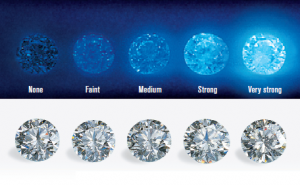GIA’s 4Cs Q&A series wraps up with some bonus information on fluorescence, while passing along a few friendly words of advice.
Fluorescence
Q: What impact does fluorescence have on the appearance of a diamond?
A: GIA studies show that, for the overwhelming majority of diamonds, the strength of fluorescence has no widely noticeable effect on appearance. In many instances, observers prefer the appearance of diamonds that have medium to strong fluorescence. In rare cases, some diamonds with extremely strong fluorescence may appear hazy or oily; fewer than 0.2% of the fluorescent diamonds submitted to GIA exhibit this effect.
Q: Does fluorescence compromise the structural integrity of the diamond?
A: No. A diamond that fluoresces has the same integrity as one with no reaction to UV. Submicroscopic substitutions and/or shifts in the diamond structure can cause fluorescence as well as prevent it. Nothing in either instance inherently weakens or is bad for the diamond.
More about diamonds Q&A
Q: How can you know whether your diamond has been treated or enhanced?
A: GIA issues reports for diamonds that have been laser drilled or HPHT processed, prominently disclosing these treatments on the report. As a further precaution, GIA also laser-inscribes the girdles of diamonds it identifies to be HPHT processed. GIA does not issue grading reports for any diamond that has undergone a treatment process that’s considered nonpermanent or unstable, such as coating or fracture filling.
Q: How do you know if your diamond is synthetic or not?
A: GIA tests every diamond to determine if it is natural. If a diamond is found to be laboratory-grown, GIA issues a Synthetic Diamond Grading Report, which looks distinctly different from the standard grading report. GIA also laser-inscribes the diamond’s girdle with a report number and a statement that the diamond has been laboratory-grown.
Q: How do you know that your diamond is natural and not a diamond simulant?
A: GIA tests every stone to verify that it is, in fact, a diamond. GIA does not issue grading reports for simulants.
For an overview on fluorescence, read “Understanding Diamond Fluorescence“. For more information on diamonds, download the GIA 4Cs app, now available on iPhone, iPad, and Android!
Color Q&A | Clarity Q&A | Cut Q&A | Carat Weight Q&A
Custom Field: Array
